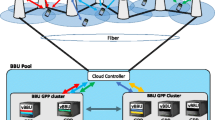Abstract
Fifth generation (5G) cell frameworks are relied upon to encounter colossal traffic congestion from mobile devices. To decrease network congestion, the 5G cell systems need to be changed to accommodate the soaring traffic demands from these devices. In a 5G network, a cloud-based radio access network (C-RAN) has a significant role to increase the data rate. With the support of C-RAN, traffic congestion in the 5G network is handled by presenting the Call Admission Control (CAC) technique. Although this CAC technique improves the system efficiency, maximum of call blocking probability due to the traffic congestion is the main challenge. So, the solution to this challenge is introducing the optimal call admission decision maker. In this paper, Artificial Fish Swarm Algorithm based Fuzzy Inference System (FIS-AFSA) is proposed as a decision maker. Using AFSA algorithm, the fuzzy parameters are optimized in this strategy. In this approach, few delay tolerant connections are outsourced from private cloud to public cloud with certain price when congestion. The proposed FIS-AFSA based CAC scheme's performance outperforms that of the Fuzzy based CAC technique in the basis of call blocking probability, throughput and resource utilization as show in simulation results.















Similar content being viewed by others
Availability of data and materials
There is no data availability.
References
Khawam, K., Lahoud, S., Ibrahim, M., Yassin, M., Martin, S., El Helouand, M., & Moety, F. (2016). Radio access technology selection in heterogeneous networks. Physical Communication, 18, 125–139
Raza, H. (2011). A brief survey of radio access network backhaul evolution: part I. IEEE Communications Magazine, 49(6), 164–171
Perez-Romero, J., Lagrange, X., Nasreddine, J., & Marquez-Barja, J. (2016). Special issue on radio access network architectures and resource management for 5G. Physical Communication, 18, 61–63
Farhat, S., Samhat, A., Lahoud, S., & Cousin, B. (2017). Radio access network sharing in 5G: strategies and benefits. Wireless Personal Communications, 96(2), 2715–2740
Checko, A. (2016). Cloud radio access network architecture. Towards 5G mobile networks. Ph.D. dissertation, Technical University of Denmark.
Wu, J., Zhang, Z., Hong, Y., & Wen, Y. (2015). Cloud radio access network (C-RAN): a primer. IEEE Network, 29(1), 35–41
Wang, X. (2010). C-RAN: The road towards green RAN. China Communication Journal.
Nikaein, N. (2015). Processing radio access network functions in the cloud: Critical issues and modeling. In Proceedings of the 6th international workshop on mobile cloud computing and services (pp. 36–43). ACM.
Ku, Y.-J., Lin, D.-Y., & Wei, H.-Y. (2016). Fog RAN over general purpose processor platform. In 2016 IEEE 84th vehicular technology conference (VTC-Fall). IEEE.
Sigwele, T., Pillai, P., Alam, A., & Hu, Y. (2017). Fuzzy logic-based call admission control in 5G cloud radio access networks with preemption. EURASIP Journal on Wireless Communications and Networking, 1, 2017
Gemikonakli, E., Ever, E., Mapp, G., & Gemikonakli, O. (2016). Admission control and buffer management of wireless communication systems with mobile stations and integrated voice and data services. Telecommunication Systems, 65(4), 663–675
Pandey, V., Ghosal, D., Mukherjee, B., & Wu, X. (2007). Call admission and handoff control in multi-tier cellular networks: algorithms and analysis. Wireless Personal Communications, 43(3), 857–878
Roy, K., & Misra, I. (2012). Priority based call admission control protocol for videoconference traffic in wireless/cellular networks. Procedia Technology, 4, 749–753
Ekpenyong, M., Udoh, V., & Bassey, U. (2014). Mitigating handoff call dropping in wireless cellular networks: A call admission control technique. Journal of The Institution of Engineers (India): Series B, 97(2), 167–174
Jain, M., & Mittal, R. (2015). Adaptive call admission control and resource allocation in multi server wireless/cellular network. Journal of Industrial Engineering International, 12(1), 71–80
Chowdhury, M., Jang, Y., & Haas, Z. (2013). Call admission control based on adaptive bandwidth allocation for wireless networks. Journal of Communications and Networks, 15(1), 15–24
Rao, D., & Saraf, S. (2016). Study of defuzzification methods of fuzzy logic controller for speed control of a DC motor. In Proceedings of international conference on power electronics, drives and energy systems for industrial growth.
Khan, H., et al. (2020). Joint admission control, cell association, power allocation and throughput maximization in decoupled 5G heterogeneous networks. Telecommunication Systems.
AlQahtani, S., & Altamrah, A. (2018). Supporting QoS requirements provisions on 5G network slices using an efficient priority-based polling technique. Wireless Networks, 25(7), 3825–3838
Liu, J., Lin, C., & Huang, H. (2019). Joint congestion control and resource allocation for energy-efficient transmission in 5G heterogeneous networks. EURASIP Journal on Wireless Communications and Networking, 1, 2019
Othman, A., & Nayan, N. (2019). Efficient admission control and resource allocation mechanisms for public safety communications over 5G network slice. Telecommunication Systems, 72(4), 595–607
Jadhav, V., & Kolekar, U. (2019). Fuzzy-based decisive approach for call admission control in the LTE networks. Evolutionary Intelligence.
Panno, D., & Riolo, S. (2020). An enhanced joint scheduling scheme for GBR and non-GBR services in 5G RAN. Wireless Networks, 26(4), 3033–3052
Li, S., Wang, Q., Kou, W., & Tan, D. (2018). Joint remote radio heads and baseband units pool resource scheduling for delay-aware traffic in cloud radio access networks. Telecommunication Systems, 71(1), 77–91
Agrawal, R., Bedekar, A., Kolding, T., & Ram, V. (2017). Cloud RAN challenges and solutions. Annals of Telecommunications, 72(7–8), 387–400
Funding
The authors declare that they have competing interests and funding.
Author information
Authors and Affiliations
Contributions
All authors read and approved the final manuscript.
Corresponding author
Ethics declarations
Conflict of interests
On behalf of all authors, the corresponding author states that there is no conflict of interest.
Additional information
Publisher's Note
Springer Nature remains neutral with regard to jurisdictional claims in published maps and institutional affiliations.
Rights and permissions
About this article
Cite this article
Suresh, K., Kumaratharan, N. Call Admission Control Decision Maker Based on Optimized Fuzzy Inference System for 5G Cloud Radio Access Networks. Wireless Pers Commun 120, 749–769 (2021). https://doi.org/10.1007/s11277-021-08487-z
Accepted:
Published:
Issue Date:
DOI: https://doi.org/10.1007/s11277-021-08487-z




